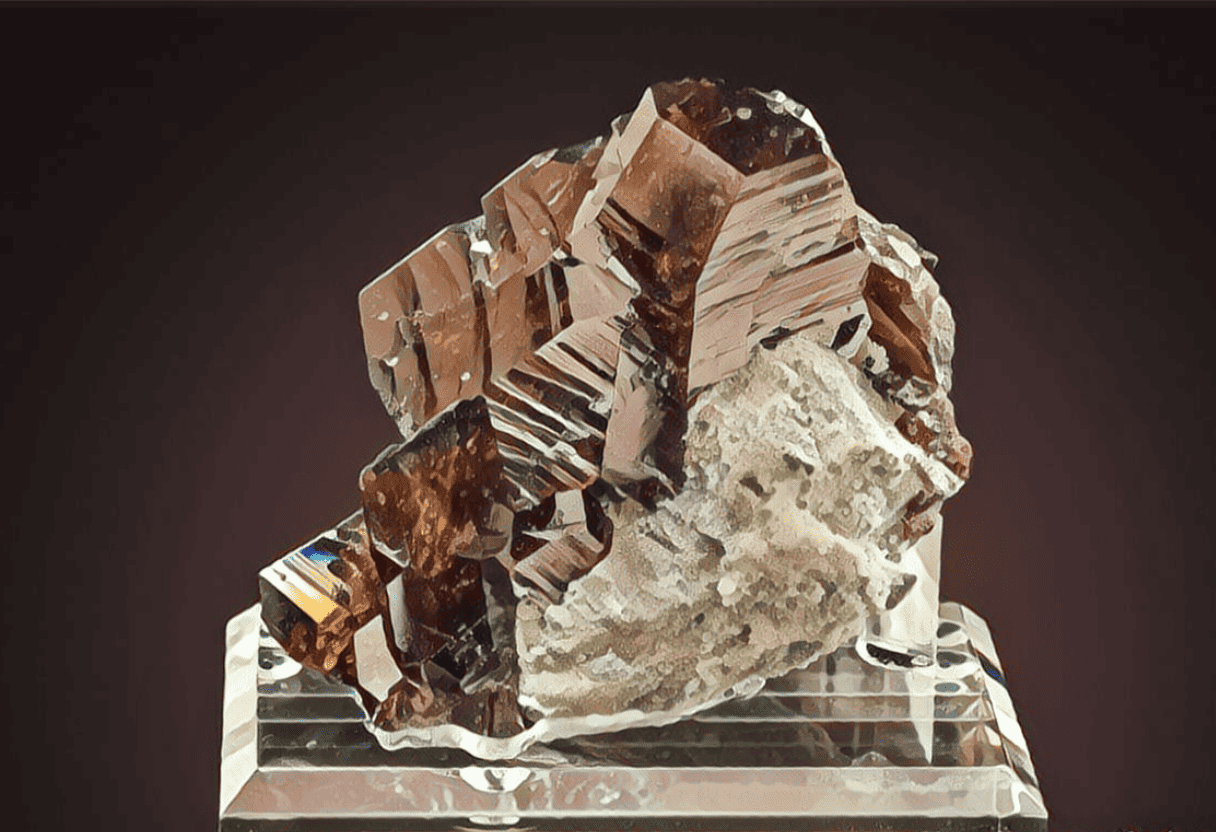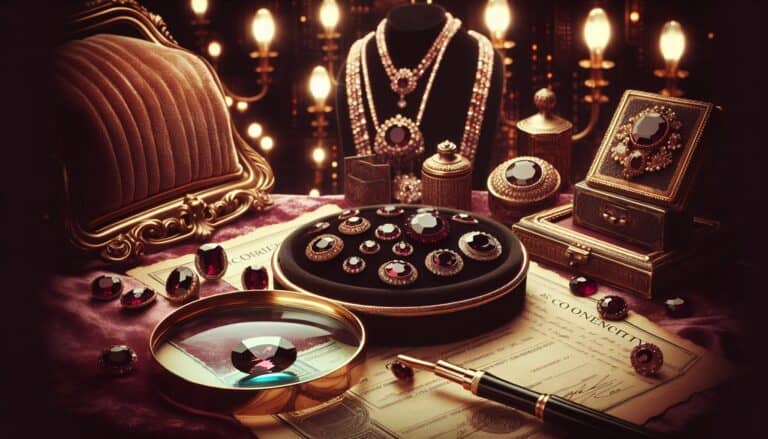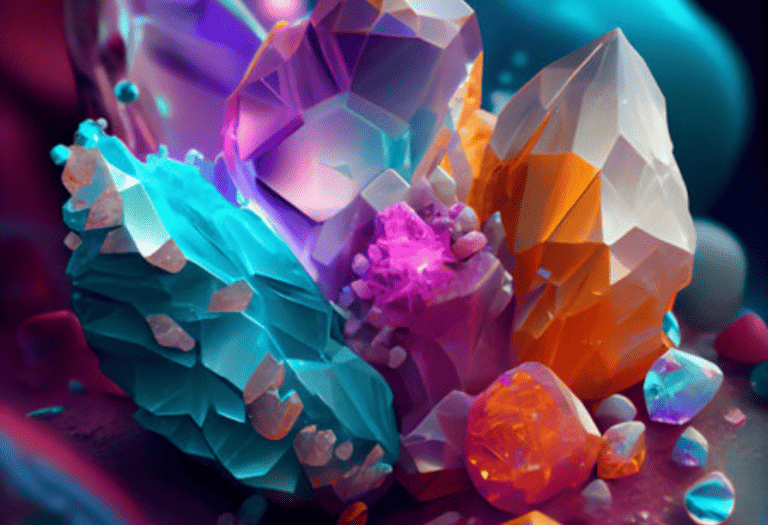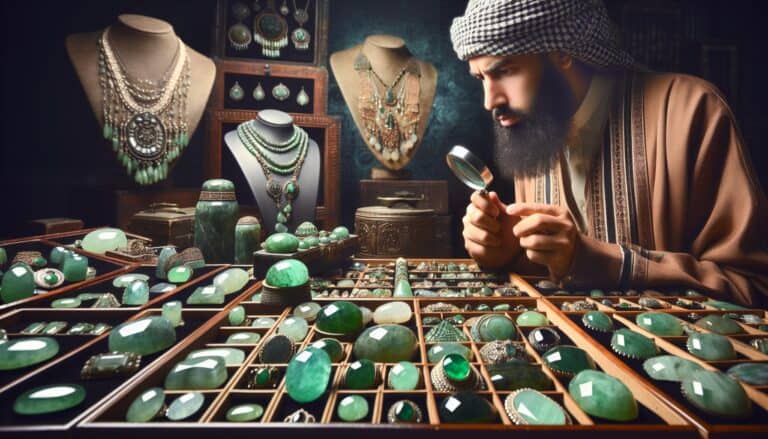Ever wondered about the value of the mesmerizing axinite?
I’ve always been fascinated by its unique color and rarity. As a gemstone enthusiast, I’m here to shed some light on what factors into the worth of axinite.
Determining axinite’s value isn’t straightforward; it’s influenced by several factors like color, clarity, cut, and carat weight. I’ll guide you through what makes some axinite stones more valuable than others.
Whether you’re a collector, jeweler, or simply curious, understanding axinite’s worth is intriguing. It’s not just about the price tag; it’s about appreciating a gemstone’s true beauty and rarity. Let’s dive into the world of axinite and discover what makes it a treasure in the gem market.
Axinite’s value is influenced by color, clarity, cut, and carat weight, with its rare pleochroism and limited mining locations adding to its allure. High-quality, large, clear, and vibrantly colored pieces are especially valuable in the gem market.
What Is Axinite
When I’m asked about axinite, I always start by saying it’s one of the most intriguing gemstones out there. It boasts a unique glassy luster and can display an array of colors – from honey-brown to deep blues and violets. Most importantly, its triclinic crystal system gives it an unmistakable complex geometry and sets it apart visually from other stones.
Axinite’s composition includes a mix of calcium, aluminum, boron, and iron among other elements, creating a hardness of 6.5 to 7 on the Mohs scale. This means it’s reasonably scratch-resistant but still requires care to maintain its natural beauty.
The fascinating thing about axinite is its pleochroic nature, meaning it exhibits different colors when viewed from various angles. This characteristic is especially appealing to gem enthusiasts and is a significant contributor to its value. The gemstone’s color shift is not just a visual trick but a testament to its complex structure and the unique conditions under which it forms.
Mining locations for axinite are quite scattered and often remote. Significant deposits have been found in places such as Mali, Pakistan, and Russia. The diversity of its sources contributes to the gemstone’s rarity and allure.
Collectors and those who appreciate natural artistry are often drawn to axinite for its subtle yet striking beauty. It’s not just the gemstone’s rarity that captivates but also the perfection of its formation. With each piece, I see the mysterious depths of the earth captured in crystalline form, a marvel that’s as fascinating to hold as it is to behold.
Understanding this gemstone’s characteristics can help in comprehending why its worth is measured not just in carats or clarity but also in the sheer uniqueness of each specimen. Appreciating axinite goes beyond economics; it’s about valuing the marvels of the natural world.
Understanding Axinite Value
When determining the worth of axinite, it’s crucial to consider several factors that play into its valuation. One primary determinant is color. Axinite comes in a range of hues from cinnamon to brownish-purple, with the most sought-after color being a clear, rich purple-brown.
Another key factor is clarity. Like most gemstones, the fewer inclusions or blemishes within the stone, the higher its value. Axinite’s natural clarity is generally good, but high clarity specimens are especially prized by collectors and gem enthusiasts.
The size of the gemstone can also greatly influence its worth. Larger pieces of axinite are quite rare, making them significantly more valuable. Notably, axinite crystals tend not to grow very large, so when you encounter a big crystal, it’s usually considered a remarkable find.
| Factor | Impact on Axinite Value |
|---|---|
| Color | Primary determinant |
| Clarity | Higher with fewer inclusions |
| Size | Bigger is rarer and more valuable |
Moreover, the cut of the stone affects its allure and, consequently, its market price. A well-executed cut can enhance axinite’s pleochroism, making it display its unique color-changing properties more vividly, which can be mesmerizing.
The origin of the stone is another aspect that can contribute to its worth. Axinite from certain localities, such as those in Russia or France, can be more valuable due to their quality or the stone’s history.
Lastly, the current market demand helps set the price. The rarity of axinite, combined with its desirability among collectors, keeps demand steady. This steady demand, coupled with its scarcity in nature, ensures that axinite maintains a relatively high value in the gem market.
Determining the precise value of an axinite gem requires expert evaluation. Gemologists assess every aspect of the stone, from its physical characteristics to its provenance, to provide a reliable estimation of its worth. The unique beauty and rarity of axinite make every piece a treasure, but it’s the sum of its qualities that truly defines its value in the eyes of enthusiasts and experts alike.
Factors Influencing Axinite Worth
When considering the valuation of axinite, certain characteristics have a significant impact on its market price. I’ll break down the main elements that gem collectors and connoisseurs usually weigh when assessing axinite gems.
Color and Transparency
Axinite’s color spectrum is quite diverse, ranging from honey-brown to pleasant violet. Gems showcasing deep, intense colors are typically more sought after and thus more valuable. A unique attribute of axinite is its pleochroism, meaning it displays different colors when viewed from different angles. This adds to the individuality and charm of each stone.
The degree of transparency within an axinite gem also contributes to its worth. Higher transparency indicates fewer inclusions and is a desirable trait. It’s important to note that even slight variations in color or transparency can greatly affect the value of axinite.
Size and Carat Weight
In the realm of gemstones, size matters, and axinite is no exception. Bigger stones usually come with a heftier price tag, yet it’s not just about size alone.
| Carat Weight | Impact on Value |
|---|---|
| Under 1 Carat | Less valuable |
| 1-5 Carats | Moderately valuable |
| Over 5 Carats | Highly valuable |
Larger specimens over five carats that maintain high quality in color and clarity command premium prices. It’s a rarity to find axinite in such sizes, which escalates their worth even more.
Clarity and Luster
When gauging the worth of axinite, clarity plays an influential role. Stones with minimal imperfections or inclusions are considered top-grade and are exceedingly rare. High clarity in axinite ensures that the gem’s pleochroic properties are displayed vividly, which is a prized feature by collectors.
The luster of axinite should not be overlooked. A well-polished axinite with exceptional luster reflects light beautifully, making it more appealing to buyers. This reflective quality adds to the gem’s visual appeal and, by extension, to its market value. An axinite’s ability to sparkle and shine can turn an otherwise ordinary stone into a captivating gem.
Axinite Rarity and Origins
Geographical Sources of Axinite
Axinite is a unique gemstone that’s typically found in specific pockets of the globe. The main sources of axinite are usually linked to areas where metamorphic rocks are present, as it’s in such geological settings that the stone forms. From the rich, mineral-laden soils of Pakistan to the rugged, mountainous terrains of Russia, axinite can emerge from the earth in a number of locales. Other notable countries that have uncovered significant axinite deposits include Mexico, France, and the United States, particularly in California where some of the finest specimens have been found. These geographical sources each produce axinite with distinct characteristics:
- Pakistan: Renowned for its boron-rich minerals including axinite.
- Russia: Siberian deposits are known for their lustrous and richly colored stones.
- Mexico: Offers diverse mineralogy, including axinite finds.
- France: Historical deposits with classic gem-quality specimens.
- USA (California): Famed for some of the highest quality axinite gems.
The Rarity of Quality Specimens
When it comes to quality specimens, axinite’s rarity scales up significantly. High-quality axinite gems are those that exhibit the most desirable combination of traits—vibrant colors, exceptional clarity, and an alluring luster. Due to the specific conditions required for its formation, top-grade axinite is relatively rare, which is often reflected in its price. The best pieces would typically have:
- Deep, saturated colors: Preferably with the pleochroic ability to change color depending on the angle of light.
- Remarkable clarity: Free from inclusions that may detract from the stone’s luster.
- Superior luster: An adamantine to vitreous sheen that enhances its appeal.
Finding such specimens requires meticulous searching and, often, miners may only discover a small percentage of axinite that meets this high standard within a given deposit. Consequently, gemstone enthusiasts and collectors alike prize these rarities and they are highly sought after in the market. The research and expertise put into hunting down these exceptional stones directly influence axinite’s valuation, making every high-quality finding a notable event in the gemstone community.
Pricing Trends for Axinite
Market Demand for Axinite
Tracking the market demand for axinite is fascinating because it reveals much about the gemstone’s allure and rarity. As with many gems, the law of supply and demand plays a significant role in its valuation. Axinite is no exception. With such distinct characteristics depending on their geographical origin, enthusiasts and collectors often seek out the finest pieces, driving up demand. This high demand is reflected in the upward trend in prices, especially for axinite with the most desirable features: rich color, superior clarity, and that entrancing luster I mentioned earlier.
One factor influencing the market demand for axinite is the rise of alternative investments. Gemstones and rare minerals are becoming attractive assets for investors looking to diversify their portfolios. As a rare mineral, axinite has piqued the interest of these savvy investors. I’ve noticed a steady influx of new buyers in the market, eager to own a piece of this rare gem. It’s clear that they’re not solely in it for the beauty—there’s a real appreciation for axinite’s potential as a long-term investment.
Comparative Values with Other Gemstones
When we compare axinite to other gemstones, it’s important to consider several key factors. Each gem has its own set of quality parameters, and these standards directly impact pricing. Color, clarity, cut, and carat weight—the renowned four Cs of gemstone grading—serve as a benchmark for comparison.
Let’s take a brief look at how axinite stands against some other well-known gemstones in terms of value:
- Diamond: The most coveted of all gemstones. High-quality diamonds are valued considerably higher than axinite due to their widespread popularity and use in jewelry.
- Emerald: Known for its deep green color, emerald can fetch higher prices for top-grade stones. However, axinite that showcases exceptional clarity and unique hues can hold its own in the market.
- Sapphire: With its range of colors and significant hardness, sapphires often command high prices. Axinite, while not as hard, has a unique color palette that appeals to certain collectors and jewelers.
- Tourmaline: This is perhaps the closest in comparison with axinite. Both come in a range of colors and are sought after by collectors. Tourmaline, more abundant, often has a lower price point for comparable grades.
What sets axinite apart is its rarity and the subtle shifts in color that certain varieties exhibit. It’s not every day you come across a stone that changes nuance depending on the lighting. Quality axinite with such characteristics can attract prices that rival or sometimes exceed those of more common gemstones.
The market for gemstones is a complex arena and data on current value trends is essential for buyers and sellers alike. Here’s a quick snapshot of average prices for fine quality axinite compared to the aforementioned gems:
The Most Expensive Axinite
When talking about top-tier axinite, record-breaking sales at prestigious auctions are a common highlight. These exceptional pieces fetch prices that reflect their immaculate beauty and rarity. The most expensive axinite specimens often feature an extraordinary color or an unusual crystal formation, making them highly sought after by collectors and connoisseurs alike.
High-quality axinite can command prices upwards of several thousand dollars per carat. In fact, instances have been reported where premier stones have been sold for more than $10,000 per carat. The factors contributing to such remarkable price tags include:
- Clarity: Flawless specimens are a rarity in themselves.
- Color: The more intense and unique the color, the higher the value.
- Size: Larger stones with exceptional qualities are uncommon and thus, more valuable.
- Origin: Stones from historic or renowned locales can command a premium.
| Quality of Axinite | Price Range per Carat |
|---|---|
| Good | $100 – $300 |
| Better | $300 – $1,000 |
| Best | Over $1,000 |
The variance in these prices illustrates the significant impact that factors such as clarity, color, and carat weight have on the gemstone’s worth. As with fine art, an axinite’s value can also be subjective, often resting on the individual appeal of a piece to a particular buyer.
Investment in axinite has grown with the rise in popularity of colored gemstones in the marketplace. Savvy investors often eye rare specimens of axinite, banking on their potential to appreciate in value over time. The market for these gems is dynamic; it’s driven by trends, collector interest, and the economic principles of scarcity.
While not every piece of axinite will break the bank, those that do are not just gemstones—they’re treasures of nature with their own unique stories to tell. As I delve further into the nuances of the axinite market, it’s clear that understanding these stories, and the factors that contribute to their value, is key to appreciating the true worth of these exceptional gemstones.
How to Appraise Axinite
When you’re looking to determine the value of axinite, understanding the appraisal process is key. Appraising a gemstone like axinite involves a meticulous examination of its quality and characteristics to ascertain its market value. Here’s a breakdown of how this process is typically carried out by professionals in the field.
Expert Evaluation Techniques
Gemstone experts apply a variety of techniques during an appraisal. First and foremost, visual inspection under proper lighting is essential. I’ll look for the stone’s clarity, color uniformity, and any inclusions that might affect its value.
The use of tools such as a loupe or microscope is standard to get an up-close look at the gem’s surface and interior. Through these devices, I can see the fine details that might escape the naked eye. Refractometers and spectrometers come next, measuring the gemstone’s optical properties, which can be signature indicators of axinite’s authenticity and quality.
For a more complete evaluation, I consider the Four C’s—Carat, Cut, Clarity, and Color. Axinites are no different when it comes to these industry standards:
- Carat weight directly influences value; the heavier the gemstone, generally, the more valuable it is.
- Cut quality affects how the stone refracts light, showcasing its brilliance and fire.
- Clarity is gauged by the presence and visibility of inclusions or blemishes.
- Color is particularly crucial for axinite, with more intense and desirable hues fetching higher prices.
Gemologists will use all these factors in tandem to derive the most accurate assessment of axinite’s worth.
Certification and Appraisal Resources
Accurate appraisals rely on credible sources. It’s always recommended to seek certified gemologists and reputable appraisal institutions when looking to determine the value of axinite. Renowned organizations like the Gemological Institute of America (GIA) or the American Gem Society (AGS) offer services that can be trusted. They provide certifications which act as a stamp of authenticity and detail the quality of the gemstone.
Aside from professional bodies, several online resources and tools can assist in preliminary valuations. These can be particularly useful when you’re trying to get a ballpark figure before diving into official appraisals. However, it should be noted that in-person examinations by certified professionals carry more weight and are more accurate due to the hands-on assessment of the stone.
Tips for Buying and Selling Axinite
Where to Buy Axinite
When I’m looking to buy axinite, I prioritize finding reputable dealers who offer transparency regarding their gemstones’ origins and quality. Jewelers, gem shows, and specialized online marketplaces are often rich sources for these rare gemstones. It’s crucial to perform due diligence before making a purchase. Here are some key steps I follow:
- Research Reputable Sellers: Read reviews and check for affiliations with gemological associations.
- Request Documentation: Always ask for certificates of authenticity and origin.
- Inspect the Gemstone: If possible, examine the axinite in person or request high-quality photos and videos.
Online resources have made it easier to access axinite from remote locations. Websites like Etsy and eBay might have listings, but buyer beware—the authenticity of these platforms varies significantly. I recommend opting for specialized online retailers with robust return policies in case the gemstone doesn’t meet your expectations.
How to Sell Axinite Safely
Selling axinite requires knowledge of the current market and an understanding of who the potential buyers might be. Collectors and gem enthusiasts often look for unique pieces. To ensure a safe and profitable sale, I take the following precautions:
- Get It Appraised: Having the axinite professionally appraised can give me an accurate selling price.
- Provide Clear Information: Disclose the gemstone’s characteristics transparently to potential buyers.
- Choose the Right Platform: Selling through consignment shops, auctions, or online marketplaces that cater to gem enthusiasts can lead to better deals.
When I list axinite for sale online, I make sure my listing stands out with detailed descriptions, professional images, and information about the stone’s certification. These steps not only help protect my investment but also build trust with buyers, potentially leading to higher offers and a more seamless selling experience.
Selling directly to end-users can be rewarding but also challenging. I consider outlets like social media groups or forums dedicated to gemstone trading for reaching interested buyers who appreciate axinite’s unique properties. Keeping safety in mind, secure payment methods and insured shipping options are non-negotiables for any transaction I initiate.
Conclusion: Buying & Selling Axinite
Determining axinite’s worth is an intricate dance between rarity, market demand, and the gemstone’s inherent allure. I’ve shared insights on how to navigate the buying and selling process, emphasizing the need for due diligence and expertise.
Whether you’re looking to invest in axinite or find a new home for your precious stone, remember that knowledge is power.
By following the advice on reputable sellers, accurate appraisals, and secure transactions, you’ll be well-equipped to make informed decisions. Axinite’s value may fluctuate, but with the right approach, you can maximize your investment and enjoy the beauty and financial benefits of this rare gem.







